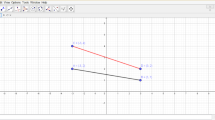Abstract
Past research has shown that many scientists, when asked to interpret unfamiliar graphs that have nevertheless been culled from introductory undergraduate courses in their own field, experience problems and cannot give the standard answer accepted in the field. Yet, these same scientists turn out to be highly competent when it comes to graphs from their immediate domain of research. In this research, which is based on ethnographic studies among scientists and technicians, I show how graph interpretation in one biology laboratory initially required tool (computer)mediation. After scientists had become familiar with the phenomenon, data collection,and resulting graphs, they interpret the latter correctly without requiring prior transformation. Furthermore, in the course of their work, they established what they understood to be a one-to-one correspondence between graphs and some aspect of the natural world. As a result of scientists' embodied laboratory work, talk about the graphical representation and talk about the object represented are often indistinguishable. The process of developing competency in graph use is equivalent to that of a tool that becomes transparent to the consciousness of its user;I describe this process in terms of activity theory as a transition from tool-mediated action to operation.
Similar content being viewed by others
REFERENCES
Cobb, P. and Tzou, C. (in press). Supporting students' learning about data creation. Cognition & Instruction.
Engeström, Y. (1987). Learning by Expanding: An Activity-theoretical Approach to Developmental Research. Helsinki: Orienta-Konsultit.
Garfinkel, H., Lynch, M. and Livingston, E. (1981). The work of a discovering science construed with materials from the optically discovered pulsar. Philosophy of the Social Sciences 11: 131-158.
Goodwin, C. (1995). Seeing in depth. Social Studies of Science 25: 237-274.
Greeno, J.G. (1989). Situations, mental models, and generative knowledge. In D. Klahr and K. Kotovsky (Eds), Complex Information Processing: The Impact of Herbert A. Simon (pp. 285-318). Hillsdale, NJ: Lawrence Erlbaum Associates.
Holzkamp, K. (1993). Lernen. Subjektwissenschaftliche Grundlegung [Learning: A Perspective from Subject-Centered Science]. Frankfurt/M.: Campus Verlag.
Janvier, C. (1987). Translation processes in mathematics education. In C. Janvier (Ed.), Problems of Representation in the Teaching and Learning of Mathematics (pp. 27-32). Hillsdale, NJ: Lawrence Erlbaum Associates.
Kirsh, D. and Maglio, P. (1994). On distinguishing epistemic from pragmatic action. Cognitive Science 18: 513-549.
Leinhardt, G., Zaslavsky, O. and Stein, M. K. (1990). Functions, graphs, and graphing: Tasks, learning, and teaching. Review of Educational Research 60: 1-64.
Leontév, A. N. (1978). Activity, Consciousness and Personality. Englewood Cliffs, CA: Prentice Hall.
Lynch, M. (1992). Extending Wittgenstein: The pivotal move from epistemology to the sociology of science. In A. Pickering (Ed.), Science as Practice and Culture (pp. 215-300). Chicago: The University of Chicago Press.
Meira, L. (1995). The microevolution of mathematical representations in children's activity. Cognition and Instruction 13: 269-313.
Meira, L. (1998). Making sense of instructional devices: The emergence of transparency in mathematical activity. Journal for Research in Mathematics Education 29: 121-142.
Nemirovsky, R. and Monk, S. (in press). If you look at it the other way ...An exploration into the nature of symbolizing. In P. Cobb, E. Yackel and K. McClain (Eds), Symbolizing and Communicating in Mathematics Classrooms: Perspectives on Discourse, Tools, and Instructional Design. Mahwah, NJ: Lawrence Erlbaum Associates.
Nemirovsky, R., Tierney, C. and Wright, T. (1998). Body motion and graphing. Cognition and Instruction 16: 119-172.
Pozzi, S., Noss, R. and Hoyles, C. (1998). Tools in practice, mathematics in use. Educational Studies in Mathematics 36: 105-122.
Preece, J. and Janvier, C. (1992). A study of the interpretation of trends in multiple curve graphs of ecological situations. School Science and Mathematics 92: 299-306.
Roth, W.-M. (1996). Where is the context in contextual word problems?: Mathematical practices and products in Grade 8 students' answers to story problems. Cognition and Instruction 14: 487-527.
Roth, W.-M. and Bowen, G. M. (1999). Complexities of graphical representations during lectures: A phenomenological approach. Learning and Instruction 9: 235-255.
Roth, W.-M. and Bowen, G. M. (2001a). Of disciplined minds and disciplined bodies. Qualitative Sociology 24(4): 459-481.
Roth, W.-M. and Bowen, G. M. (2001b). Professionals read graphs: A semiotic analysis. Journal for Research in Mathematics Education 32: 159-194.
Roth, W.-M., Bowen, G. M. and Masciotra, D. (2002). From thing to sign and 'natural object': Toward a genetic phenomenology of graph interpretation. Science, Technology, & Human Values 27: 327-356.
Winograd, T. and Flores, F. (1987). Understanding Computers and Cognition: A New Foundation for Design. Norwood, NJ: Ablex.
Author information
Authors and Affiliations
Rights and permissions
About this article
Cite this article
Roth, WM. Competent Workplace Mathematics: How Signs Become Transparent in Use. International Journal of Computers for Mathematical Learning 8, 161–189 (2003). https://doi.org/10.1023/B:IJCO.0000003873.36183.2d
Issue Date:
DOI: https://doi.org/10.1023/B:IJCO.0000003873.36183.2d




